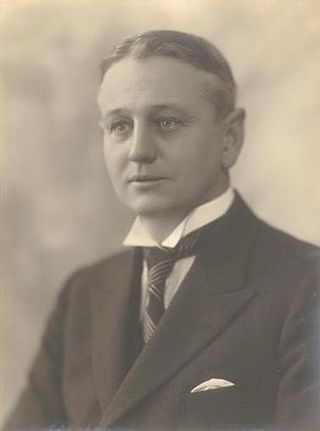Related Research Articles
Reg Date was an Australian soccer player who plied his trade after the Second World War. Date played for Wallsend Football Club and Canterbury-Bankstown. He represented Australia in five full international matches, captaining three times.
James William "Judy" Masters was a soccer player who captained the Australia national team in five matches in 1923 and 1924. He was recognised as one of Australia's best players of his time. In over 400 club and representative games he was never cautioned.

Samuel Robert Nicholls was an Australian politician. He was an Australian Labor Party member of the Australian House of Representatives from 1917 to 1922, representing the electorate of Macquarie.
Tasman (Tas) Jones was an Australian sportsman, well known as a swimmer and a diver. He also played water polo, rugby union, and rugby league.

John Lloyd (Jack) Price was an Australian politician and trade unionist. He was an Australian Labor Party member of the South Australian House of Assembly for Port Adelaide from 1915 to 1925. He later served in the Australian House of Representatives for Boothby from 1928 until his death in 1941, but left the Labor Party and joined the United Australia Party, following the 1931 Labor split over government responses to the Great Depression.
Alex Gibb was an Australian soccer player who played half-back with Queensland clubs and the Queensland and Australia national teams. Gibb is recognised as Australia's first international captain, and was awarded Socceroo cap number one retrospectively in 2000 by Football Federation Australia, for Australia's first Test match against New Zealand, played in 1922.
John Muir Peebles was an Australian soccer player, official, and administrator.
Alfred Quill was an Australian soccer player and played for the Australia national team. Often considered one of the best soccer players in New South Wales, he scored 868 goals in all NSW competitions in his 24-year senior career.
William "Podge" Maunder was an Australian soccer player. Maunder is recognised as the player who scored Australia's first international goal.

The Municipality of Granville was a local government area in the Western region of Sydney, New South Wales, Australia. The municipality was proclaimed as the Borough of Granville on 20 January 1885. It included the modern suburbs of Granville, South Granville, Camellia, Rosehill, Clyde and parts of Harris Park, Guildford and Merrylands. From 1 January 1949, the council was amalgamated into the City of Parramatta, with the passing of the Local Government (Areas) Act 1948.
George Smith was an Australian professional soccer player who played as a forward. He captained the Australia national soccer team in 1933. Often considered the best centre-forward in Australian soccer in the 1930s, he had an average of 2.66 goals per game for Australia and has had many goalscoring records throughout his 17-year career.
George Cartwright was an Australian professional soccer player. He played as a goalkeeper for the Australia national soccer team.
Coleman Phillipson was an English legal scholar and historian. He was Professor of Law at University of Adelaide 1919–1925.
Stan Bourke was a former Australian professional soccer player who played as a forward. He had three caps for the Australia national soccer team.
Thomas Ewington Howard was an Australian professional golfer. He won the Australian Open in 1923.
Allan Johns was an Australian soccer player who played for Adamstown Rosebud. Johns played 10 full international matches for Australia.
Alan Garside was an Australian soccer player who played as a forward for Granville and the Australian national team. He received a cap for his appearance and a 2020–2021 Socceroos jersey with his name on the back.
George Wishart Smith, sometimes written Wishart-Smith, was a railway executive in Western Australia and Railway Commissioner in Tasmania, from which service he was suspended after mounting costs and deteriorating patronage.
Charlie Leabeater was an Australian soccer player who played as a full-back. He played for Granville and the Australia national team. He was also a cricket player, rugby player and swimmer.
Roy McNaughton was an Australian soccer player who played as forward for the Australia national team. He played most of his senior career with Cessnock and switched a variety of Newcastle based clubs including Kurri Kurri, Weston and Aberdare afterwards.
References
- ↑ Howe, Andrew (2018). Encyclopedia of Socceroos: Every national team player. Fair Play Publishing. ISBN 978-0-648-13330-8.
- ↑ "TO RETIRE". The Daily Telegraph . No. 14, 136. New South Wales, Australia. 31 March 1925. p. 8. Retrieved 11 September 2021– via National Library of Australia.
- ↑ "THE SOCCER SEASON". Arrow . No. 1905. New South Wales, Australia. 10 April 1925. p. 15. Retrieved 9 September 2021– via National Library of Australia.
- ↑ "LURE OF SOCCER". Arrow . No. 2065. New South Wales, Australia. 27 April 1928. p. 14. Retrieved 9 September 2021– via National Library of Australia.
- ↑ "INTERNATIONAL SOCCER". The Register . Vol. LXXXIX, no. 26, 067. South Australia. 14 July 1924. p. 7. Retrieved 11 September 2021– via National Library of Australia.
- ↑ "INTER-DOMINION SOCCER". The Register . Vol. LXXXIX, no. 26, 079. South Australia. 28 July 1924. p. 6. Retrieved 11 September 2021– via National Library of Australia.
- ↑ "The Australian National Men's Football Team: Caps And Captains" (PDF). Football Federation Australia . ozfootball.net. Retrieved 23 June 2009.
- ↑ "SOCCER FOOTBALL". Referee . No. 1905. New South Wales, Australia. 12 September 1923. p. 12. Retrieved 11 September 2021– via National Library of Australia.
- ↑ "The Magpies Home". The Cumberland Argus and Fruitgrowers' Advocate . Vol. XXXVI, no. 3067. New South Wales, Australia. 26 August 1924. p. 6. Retrieved 11 September 2021– via National Library of Australia.